Civil Engineering CPD Report: Self-Assessment and Development Plan
VerifiedAdded on 2020/04/01
|12
|1859
|372
Report
AI Summary
This CPD (Continuing Professional Development) report, submitted by a civil engineering student, provides a comprehensive self-assessment and career development plan. The report begins with a self-introduction, outlining the student's background, educational journey, and career aspirations. It then delves into mega trends and challenges impacting the civil engineering industry, encompassing political, economic, social, technological, demographic, and natural factors. The student defines key goals, identifies essential skills, and references relevant literature. The report emphasizes the importance of ethics and professional values. A competency assessment is conducted, highlighting strengths, weaknesses, and areas for improvement, particularly in interpersonal and technical skills. The student analyzes strengths and weaknesses and provides references to support their findings. Finally, the report includes appendices with job descriptions and additional supporting materials, providing a detailed overview of the student's professional development journey and future plans. The report aims to showcase a student's self-assessment of skills, knowledge, and goals within civil engineering.
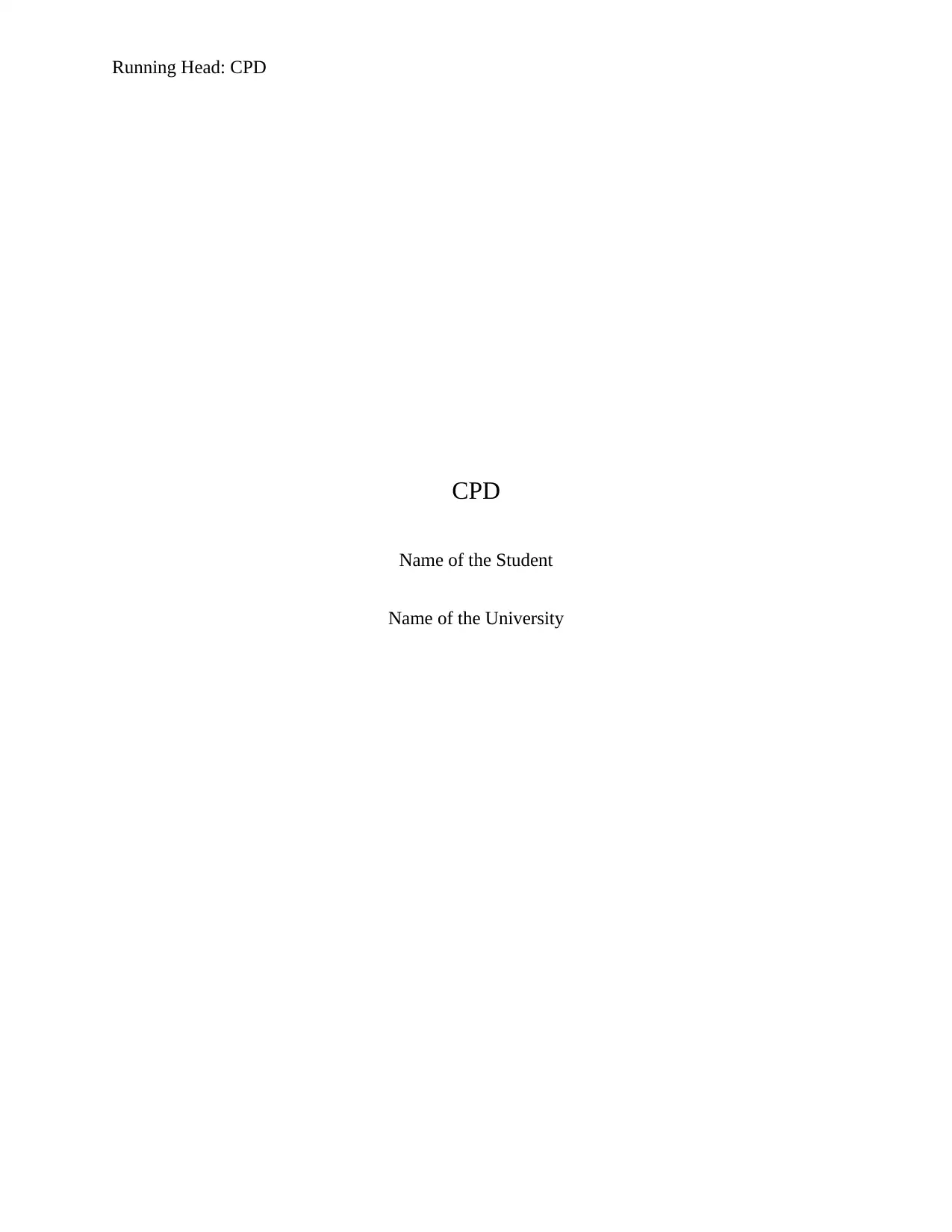
Running Head: CPD
CPD
Name of the Student
Name of the University
CPD
Name of the Student
Name of the University
Paraphrase This Document
Need a fresh take? Get an instant paraphrase of this document with our AI Paraphraser
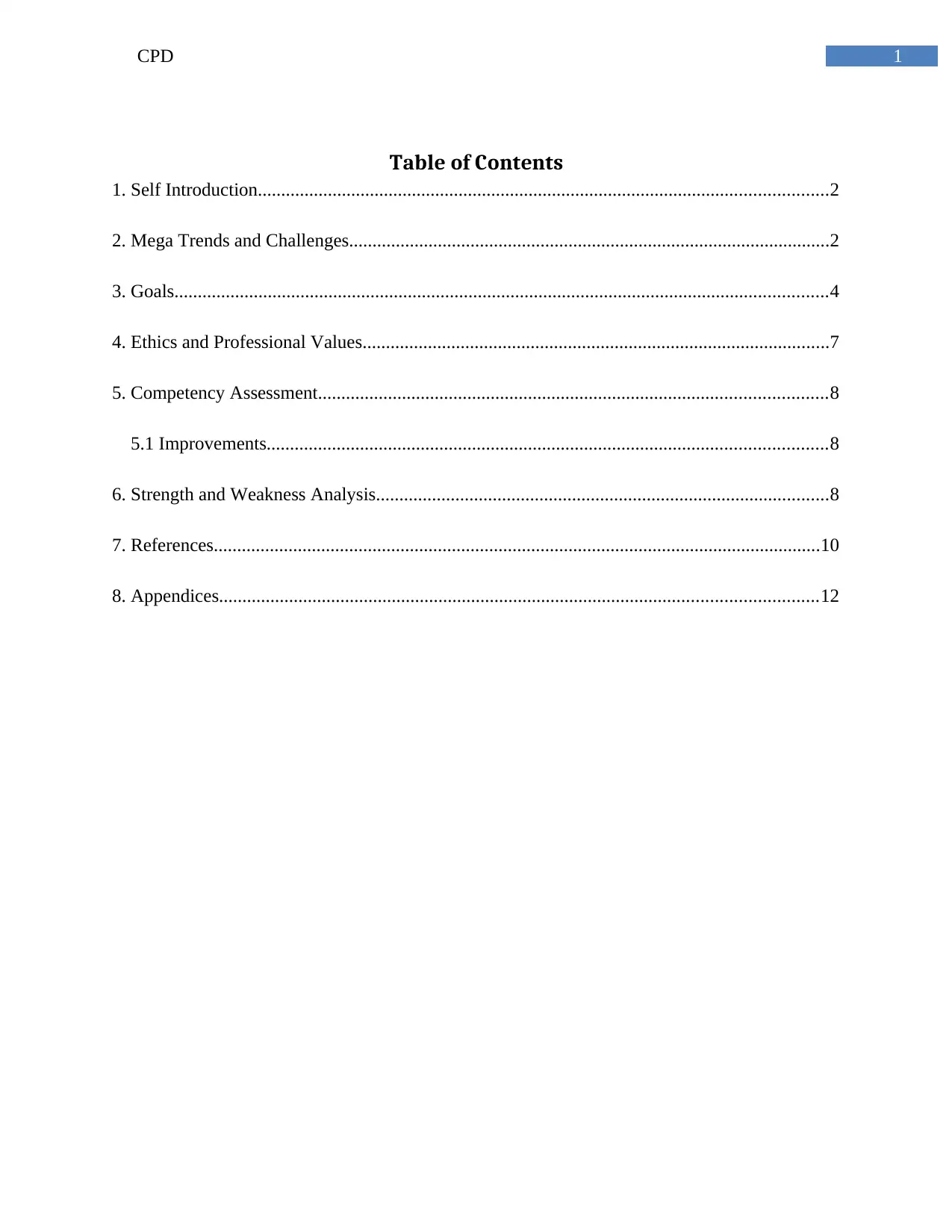
1CPD
Table of Contents
1. Self Introduction..........................................................................................................................2
2. Mega Trends and Challenges.......................................................................................................2
3. Goals............................................................................................................................................4
4. Ethics and Professional Values....................................................................................................7
5. Competency Assessment.............................................................................................................8
5.1 Improvements........................................................................................................................8
6. Strength and Weakness Analysis.................................................................................................8
7. References..................................................................................................................................10
8. Appendices................................................................................................................................12
Table of Contents
1. Self Introduction..........................................................................................................................2
2. Mega Trends and Challenges.......................................................................................................2
3. Goals............................................................................................................................................4
4. Ethics and Professional Values....................................................................................................7
5. Competency Assessment.............................................................................................................8
5.1 Improvements........................................................................................................................8
6. Strength and Weakness Analysis.................................................................................................8
7. References..................................................................................................................................10
8. Appendices................................................................................................................................12
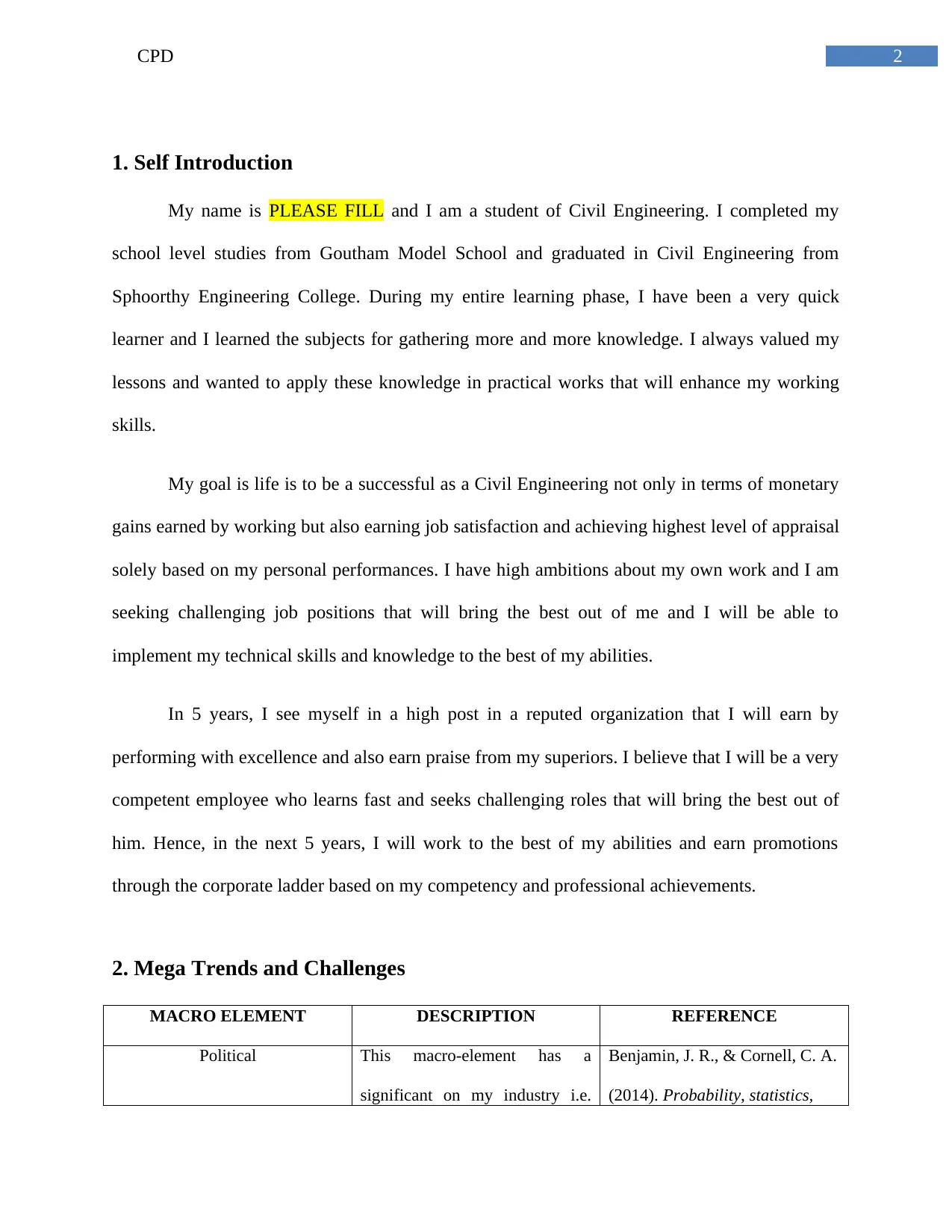
2CPD
1. Self Introduction
My name is PLEASE FILL and I am a student of Civil Engineering. I completed my
school level studies from Goutham Model School and graduated in Civil Engineering from
Sphoorthy Engineering College. During my entire learning phase, I have been a very quick
learner and I learned the subjects for gathering more and more knowledge. I always valued my
lessons and wanted to apply these knowledge in practical works that will enhance my working
skills.
My goal is life is to be a successful as a Civil Engineering not only in terms of monetary
gains earned by working but also earning job satisfaction and achieving highest level of appraisal
solely based on my personal performances. I have high ambitions about my own work and I am
seeking challenging job positions that will bring the best out of me and I will be able to
implement my technical skills and knowledge to the best of my abilities.
In 5 years, I see myself in a high post in a reputed organization that I will earn by
performing with excellence and also earn praise from my superiors. I believe that I will be a very
competent employee who learns fast and seeks challenging roles that will bring the best out of
him. Hence, in the next 5 years, I will work to the best of my abilities and earn promotions
through the corporate ladder based on my competency and professional achievements.
2. Mega Trends and Challenges
MACRO ELEMENT DESCRIPTION REFERENCE
Political This macro-element has a
significant on my industry i.e.
Benjamin, J. R., & Cornell, C. A.
(2014). Probability, statistics,
1. Self Introduction
My name is PLEASE FILL and I am a student of Civil Engineering. I completed my
school level studies from Goutham Model School and graduated in Civil Engineering from
Sphoorthy Engineering College. During my entire learning phase, I have been a very quick
learner and I learned the subjects for gathering more and more knowledge. I always valued my
lessons and wanted to apply these knowledge in practical works that will enhance my working
skills.
My goal is life is to be a successful as a Civil Engineering not only in terms of monetary
gains earned by working but also earning job satisfaction and achieving highest level of appraisal
solely based on my personal performances. I have high ambitions about my own work and I am
seeking challenging job positions that will bring the best out of me and I will be able to
implement my technical skills and knowledge to the best of my abilities.
In 5 years, I see myself in a high post in a reputed organization that I will earn by
performing with excellence and also earn praise from my superiors. I believe that I will be a very
competent employee who learns fast and seeks challenging roles that will bring the best out of
him. Hence, in the next 5 years, I will work to the best of my abilities and earn promotions
through the corporate ladder based on my competency and professional achievements.
2. Mega Trends and Challenges
MACRO ELEMENT DESCRIPTION REFERENCE
Political This macro-element has a
significant on my industry i.e.
Benjamin, J. R., & Cornell, C. A.
(2014). Probability, statistics,
⊘ This is a preview!⊘
Do you want full access?
Subscribe today to unlock all pages.

Trusted by 1+ million students worldwide
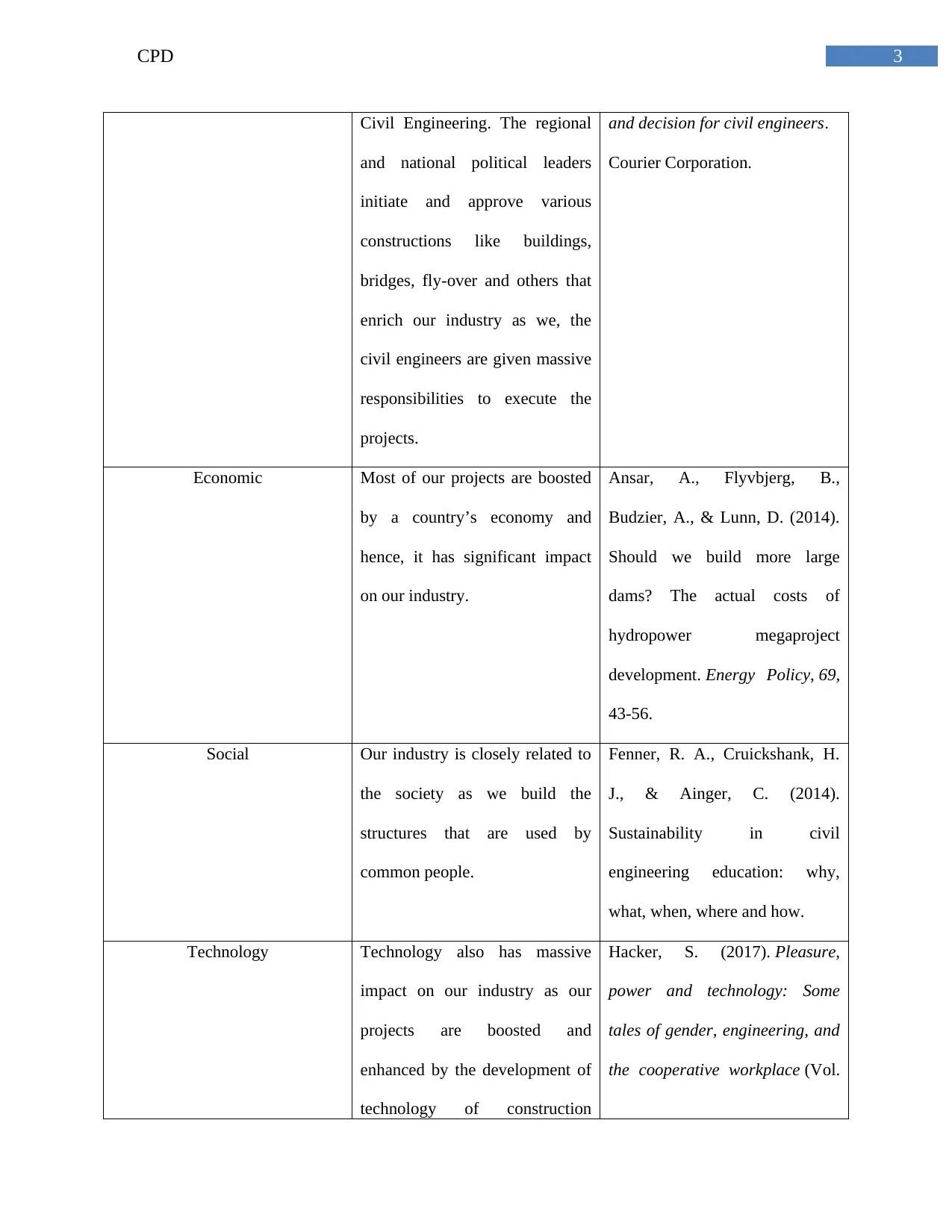
3CPD
Civil Engineering. The regional
and national political leaders
initiate and approve various
constructions like buildings,
bridges, fly-over and others that
enrich our industry as we, the
civil engineers are given massive
responsibilities to execute the
projects.
and decision for civil engineers.
Courier Corporation.
Economic Most of our projects are boosted
by a country’s economy and
hence, it has significant impact
on our industry.
Ansar, A., Flyvbjerg, B.,
Budzier, A., & Lunn, D. (2014).
Should we build more large
dams? The actual costs of
hydropower megaproject
development. Energy Policy, 69,
43-56.
Social Our industry is closely related to
the society as we build the
structures that are used by
common people.
Fenner, R. A., Cruickshank, H.
J., & Ainger, C. (2014).
Sustainability in civil
engineering education: why,
what, when, where and how.
Technology Technology also has massive
impact on our industry as our
projects are boosted and
enhanced by the development of
technology of construction
Hacker, S. (2017). Pleasure,
power and technology: Some
tales of gender, engineering, and
the cooperative workplace (Vol.
Civil Engineering. The regional
and national political leaders
initiate and approve various
constructions like buildings,
bridges, fly-over and others that
enrich our industry as we, the
civil engineers are given massive
responsibilities to execute the
projects.
and decision for civil engineers.
Courier Corporation.
Economic Most of our projects are boosted
by a country’s economy and
hence, it has significant impact
on our industry.
Ansar, A., Flyvbjerg, B.,
Budzier, A., & Lunn, D. (2014).
Should we build more large
dams? The actual costs of
hydropower megaproject
development. Energy Policy, 69,
43-56.
Social Our industry is closely related to
the society as we build the
structures that are used by
common people.
Fenner, R. A., Cruickshank, H.
J., & Ainger, C. (2014).
Sustainability in civil
engineering education: why,
what, when, where and how.
Technology Technology also has massive
impact on our industry as our
projects are boosted and
enhanced by the development of
technology of construction
Hacker, S. (2017). Pleasure,
power and technology: Some
tales of gender, engineering, and
the cooperative workplace (Vol.
Paraphrase This Document
Need a fresh take? Get an instant paraphrase of this document with our AI Paraphraser
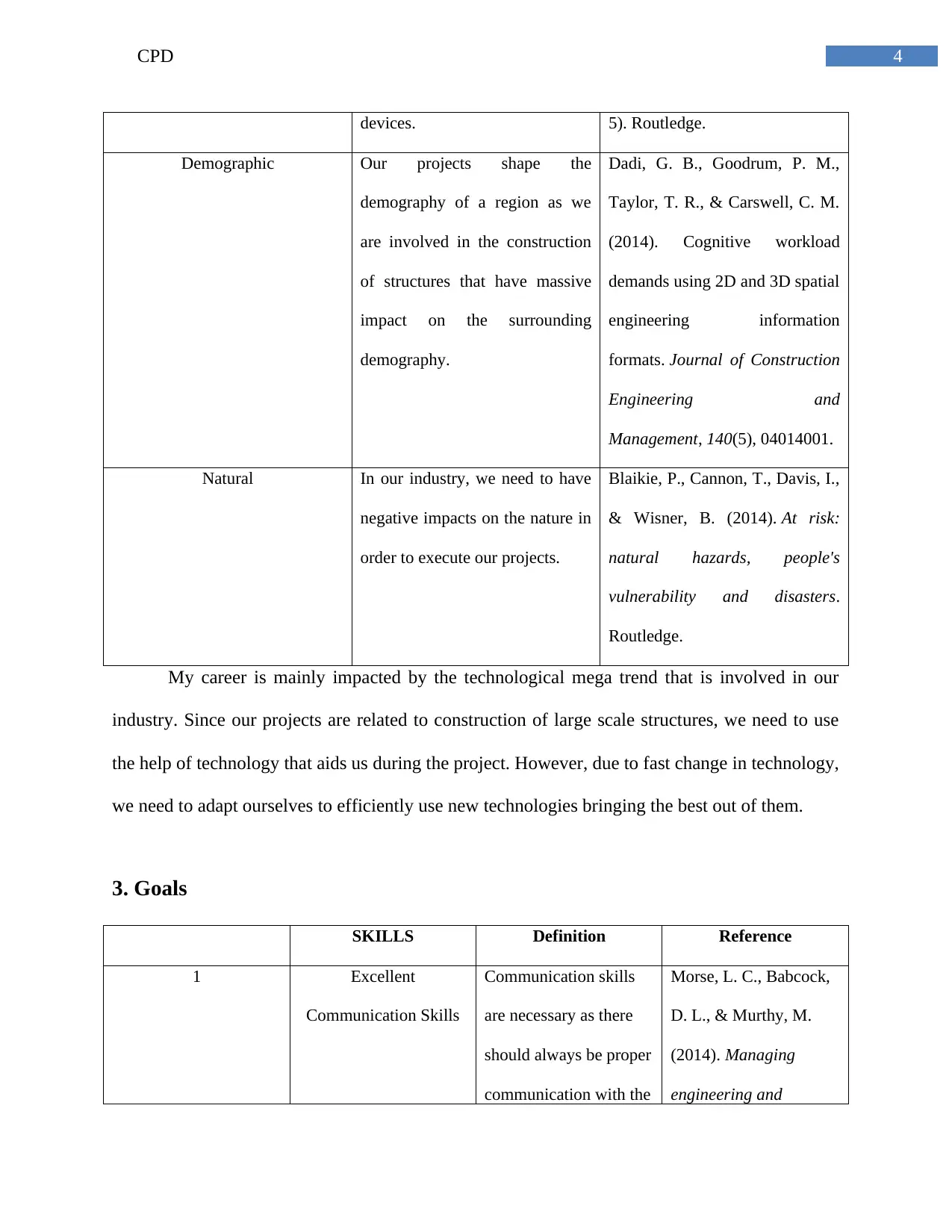
4CPD
devices. 5). Routledge.
Demographic Our projects shape the
demography of a region as we
are involved in the construction
of structures that have massive
impact on the surrounding
demography.
Dadi, G. B., Goodrum, P. M.,
Taylor, T. R., & Carswell, C. M.
(2014). Cognitive workload
demands using 2D and 3D spatial
engineering information
formats. Journal of Construction
Engineering and
Management, 140(5), 04014001.
Natural In our industry, we need to have
negative impacts on the nature in
order to execute our projects.
Blaikie, P., Cannon, T., Davis, I.,
& Wisner, B. (2014). At risk:
natural hazards, people's
vulnerability and disasters.
Routledge.
My career is mainly impacted by the technological mega trend that is involved in our
industry. Since our projects are related to construction of large scale structures, we need to use
the help of technology that aids us during the project. However, due to fast change in technology,
we need to adapt ourselves to efficiently use new technologies bringing the best out of them.
3. Goals
SKILLS Definition Reference
1 Excellent
Communication Skills
Communication skills
are necessary as there
should always be proper
communication with the
Morse, L. C., Babcock,
D. L., & Murthy, M.
(2014). Managing
engineering and
devices. 5). Routledge.
Demographic Our projects shape the
demography of a region as we
are involved in the construction
of structures that have massive
impact on the surrounding
demography.
Dadi, G. B., Goodrum, P. M.,
Taylor, T. R., & Carswell, C. M.
(2014). Cognitive workload
demands using 2D and 3D spatial
engineering information
formats. Journal of Construction
Engineering and
Management, 140(5), 04014001.
Natural In our industry, we need to have
negative impacts on the nature in
order to execute our projects.
Blaikie, P., Cannon, T., Davis, I.,
& Wisner, B. (2014). At risk:
natural hazards, people's
vulnerability and disasters.
Routledge.
My career is mainly impacted by the technological mega trend that is involved in our
industry. Since our projects are related to construction of large scale structures, we need to use
the help of technology that aids us during the project. However, due to fast change in technology,
we need to adapt ourselves to efficiently use new technologies bringing the best out of them.
3. Goals
SKILLS Definition Reference
1 Excellent
Communication Skills
Communication skills
are necessary as there
should always be proper
communication with the
Morse, L. C., Babcock,
D. L., & Murthy, M.
(2014). Managing
engineering and

5CPD
clients technology. Pearson.
2 In-depth Technical
Knowledge
Work in our industry is
entirely technical,
hence, in-depth
technical knowledge is
necessary
Abdulwahed, M., Balid,
W., Hasna, M. O., &
Pokharel, S. (2013,
August). Skills of
engineers in knowledge
based economies: A
comprehensive
literature review, and
model development.
In Teaching, Assessment
and Learning for
Engineering (TALE),
2013 IEEE
International
Conference on (pp. 759-
765). IEEE.
3 Hard Working A professional in Civil
Engineering must be
hardworking
Crawley, E. F.,
Malmqvist, J., Östlund,
S., Brodeur, D. R., &
Edström, K. (2014).
Historical accounts of
engineering education.
In Rethinking
engineering
education (pp. 231-
clients technology. Pearson.
2 In-depth Technical
Knowledge
Work in our industry is
entirely technical,
hence, in-depth
technical knowledge is
necessary
Abdulwahed, M., Balid,
W., Hasna, M. O., &
Pokharel, S. (2013,
August). Skills of
engineers in knowledge
based economies: A
comprehensive
literature review, and
model development.
In Teaching, Assessment
and Learning for
Engineering (TALE),
2013 IEEE
International
Conference on (pp. 759-
765). IEEE.
3 Hard Working A professional in Civil
Engineering must be
hardworking
Crawley, E. F.,
Malmqvist, J., Östlund,
S., Brodeur, D. R., &
Edström, K. (2014).
Historical accounts of
engineering education.
In Rethinking
engineering
education (pp. 231-
⊘ This is a preview!⊘
Do you want full access?
Subscribe today to unlock all pages.

Trusted by 1+ million students worldwide
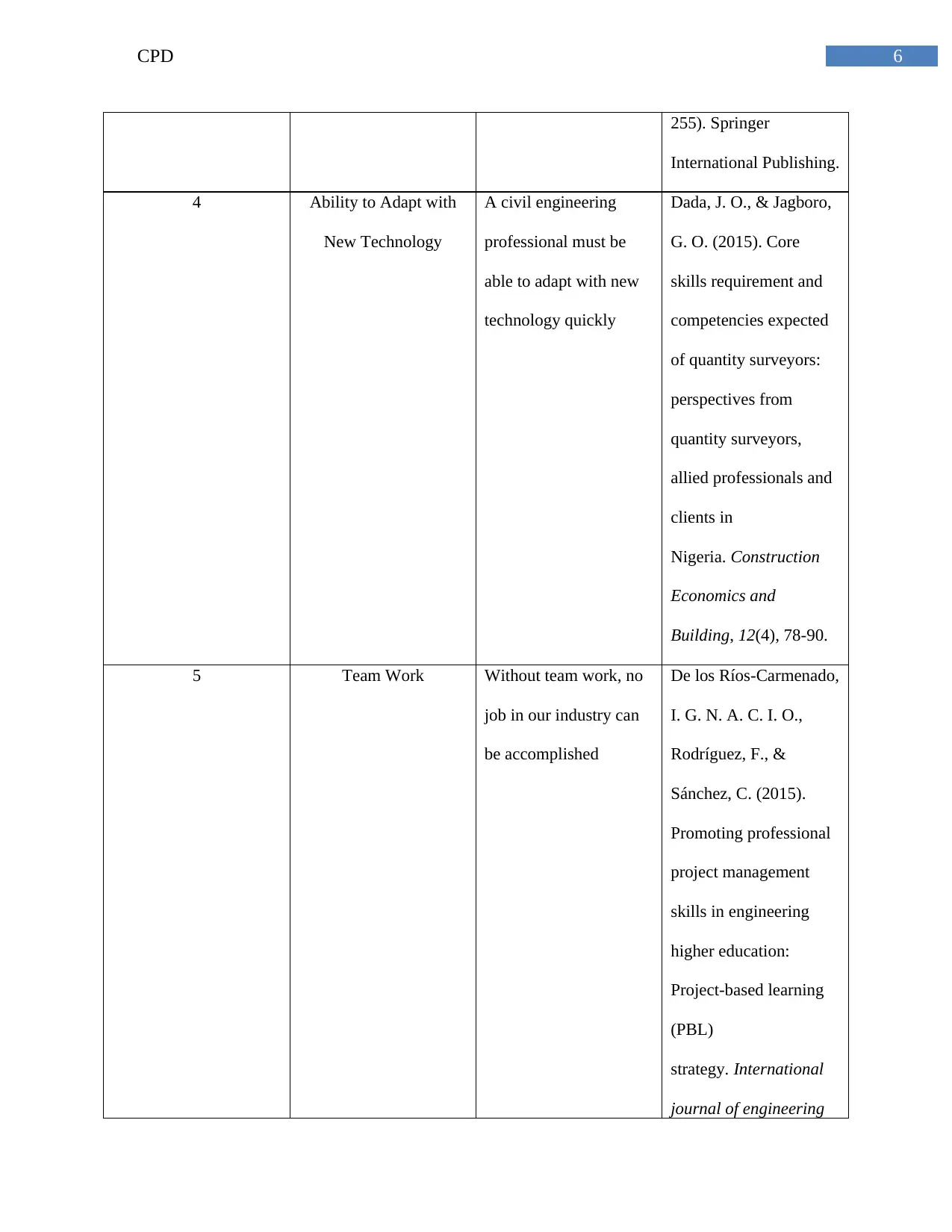
6CPD
255). Springer
International Publishing.
4 Ability to Adapt with
New Technology
A civil engineering
professional must be
able to adapt with new
technology quickly
Dada, J. O., & Jagboro,
G. O. (2015). Core
skills requirement and
competencies expected
of quantity surveyors:
perspectives from
quantity surveyors,
allied professionals and
clients in
Nigeria. Construction
Economics and
Building, 12(4), 78-90.
5 Team Work Without team work, no
job in our industry can
be accomplished
De los Ríos-Carmenado,
I. G. N. A. C. I. O.,
Rodríguez, F., &
Sánchez, C. (2015).
Promoting professional
project management
skills in engineering
higher education:
Project-based learning
(PBL)
strategy. International
journal of engineering
255). Springer
International Publishing.
4 Ability to Adapt with
New Technology
A civil engineering
professional must be
able to adapt with new
technology quickly
Dada, J. O., & Jagboro,
G. O. (2015). Core
skills requirement and
competencies expected
of quantity surveyors:
perspectives from
quantity surveyors,
allied professionals and
clients in
Nigeria. Construction
Economics and
Building, 12(4), 78-90.
5 Team Work Without team work, no
job in our industry can
be accomplished
De los Ríos-Carmenado,
I. G. N. A. C. I. O.,
Rodríguez, F., &
Sánchez, C. (2015).
Promoting professional
project management
skills in engineering
higher education:
Project-based learning
(PBL)
strategy. International
journal of engineering
Paraphrase This Document
Need a fresh take? Get an instant paraphrase of this document with our AI Paraphraser
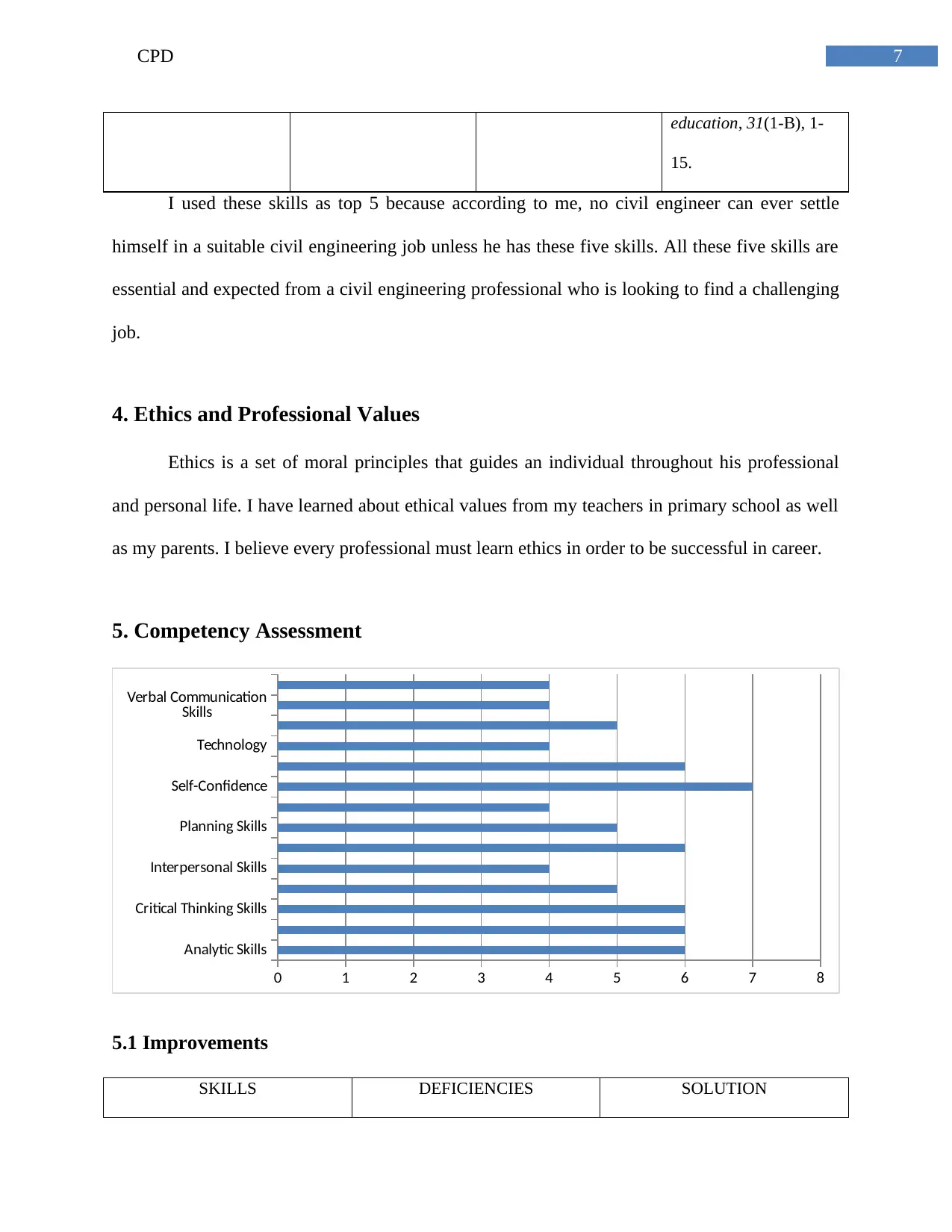
7CPD
education, 31(1-B), 1-
15.
I used these skills as top 5 because according to me, no civil engineer can ever settle
himself in a suitable civil engineering job unless he has these five skills. All these five skills are
essential and expected from a civil engineering professional who is looking to find a challenging
job.
4. Ethics and Professional Values
Ethics is a set of moral principles that guides an individual throughout his professional
and personal life. I have learned about ethical values from my teachers in primary school as well
as my parents. I believe every professional must learn ethics in order to be successful in career.
5. Competency Assessment
Analytic Skills
Critical Thinking Skills
Interpersonal Skills
Planning Skills
Self-Confidence
Technology
Verbal Communication
Skills
0 1 2 3 4 5 6 7 8
5.1 Improvements
SKILLS DEFICIENCIES SOLUTION
education, 31(1-B), 1-
15.
I used these skills as top 5 because according to me, no civil engineer can ever settle
himself in a suitable civil engineering job unless he has these five skills. All these five skills are
essential and expected from a civil engineering professional who is looking to find a challenging
job.
4. Ethics and Professional Values
Ethics is a set of moral principles that guides an individual throughout his professional
and personal life. I have learned about ethical values from my teachers in primary school as well
as my parents. I believe every professional must learn ethics in order to be successful in career.
5. Competency Assessment
Analytic Skills
Critical Thinking Skills
Interpersonal Skills
Planning Skills
Self-Confidence
Technology
Verbal Communication
Skills
0 1 2 3 4 5 6 7 8
5.1 Improvements
SKILLS DEFICIENCIES SOLUTION
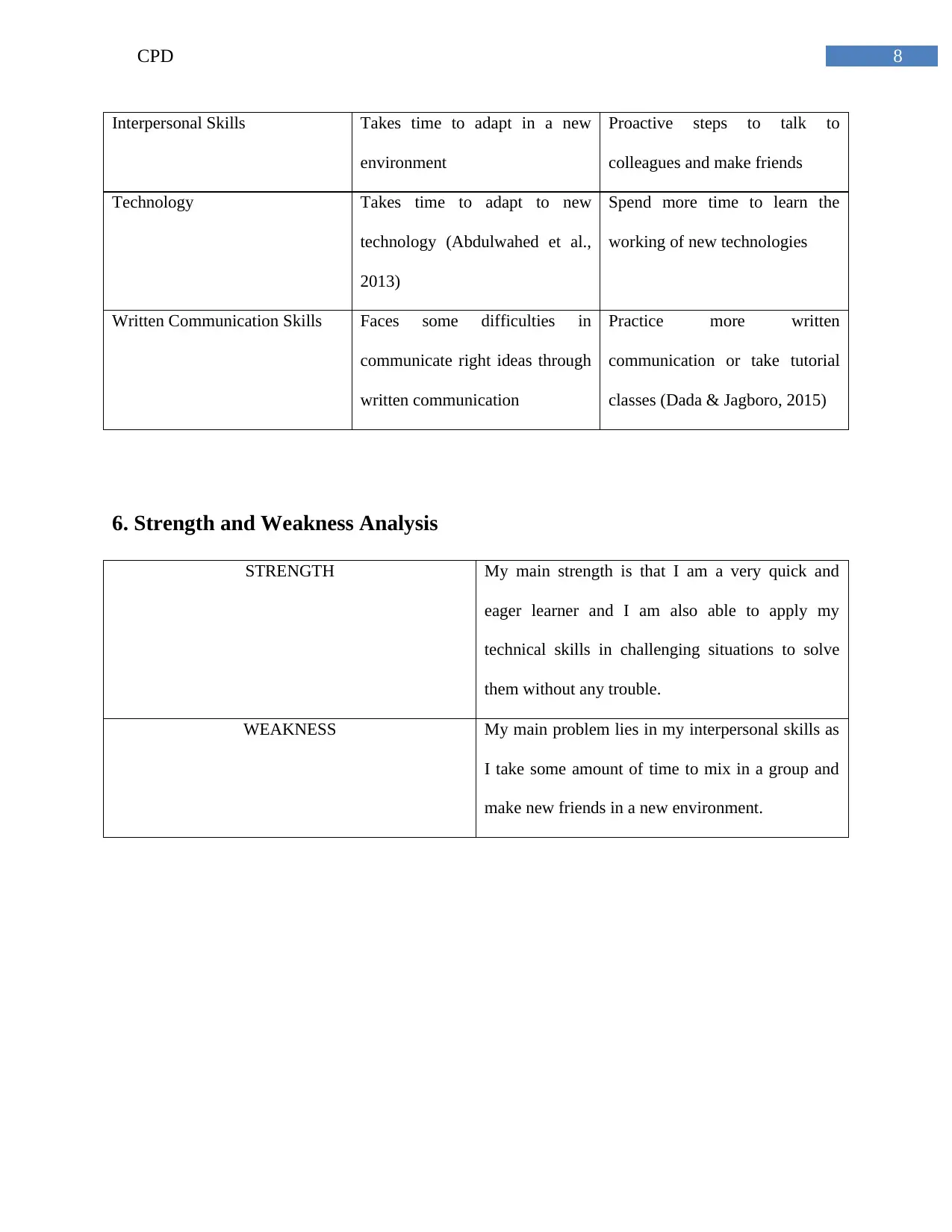
8CPD
Interpersonal Skills Takes time to adapt in a new
environment
Proactive steps to talk to
colleagues and make friends
Technology Takes time to adapt to new
technology (Abdulwahed et al.,
2013)
Spend more time to learn the
working of new technologies
Written Communication Skills Faces some difficulties in
communicate right ideas through
written communication
Practice more written
communication or take tutorial
classes (Dada & Jagboro, 2015)
6. Strength and Weakness Analysis
STRENGTH My main strength is that I am a very quick and
eager learner and I am also able to apply my
technical skills in challenging situations to solve
them without any trouble.
WEAKNESS My main problem lies in my interpersonal skills as
I take some amount of time to mix in a group and
make new friends in a new environment.
Interpersonal Skills Takes time to adapt in a new
environment
Proactive steps to talk to
colleagues and make friends
Technology Takes time to adapt to new
technology (Abdulwahed et al.,
2013)
Spend more time to learn the
working of new technologies
Written Communication Skills Faces some difficulties in
communicate right ideas through
written communication
Practice more written
communication or take tutorial
classes (Dada & Jagboro, 2015)
6. Strength and Weakness Analysis
STRENGTH My main strength is that I am a very quick and
eager learner and I am also able to apply my
technical skills in challenging situations to solve
them without any trouble.
WEAKNESS My main problem lies in my interpersonal skills as
I take some amount of time to mix in a group and
make new friends in a new environment.
⊘ This is a preview!⊘
Do you want full access?
Subscribe today to unlock all pages.

Trusted by 1+ million students worldwide
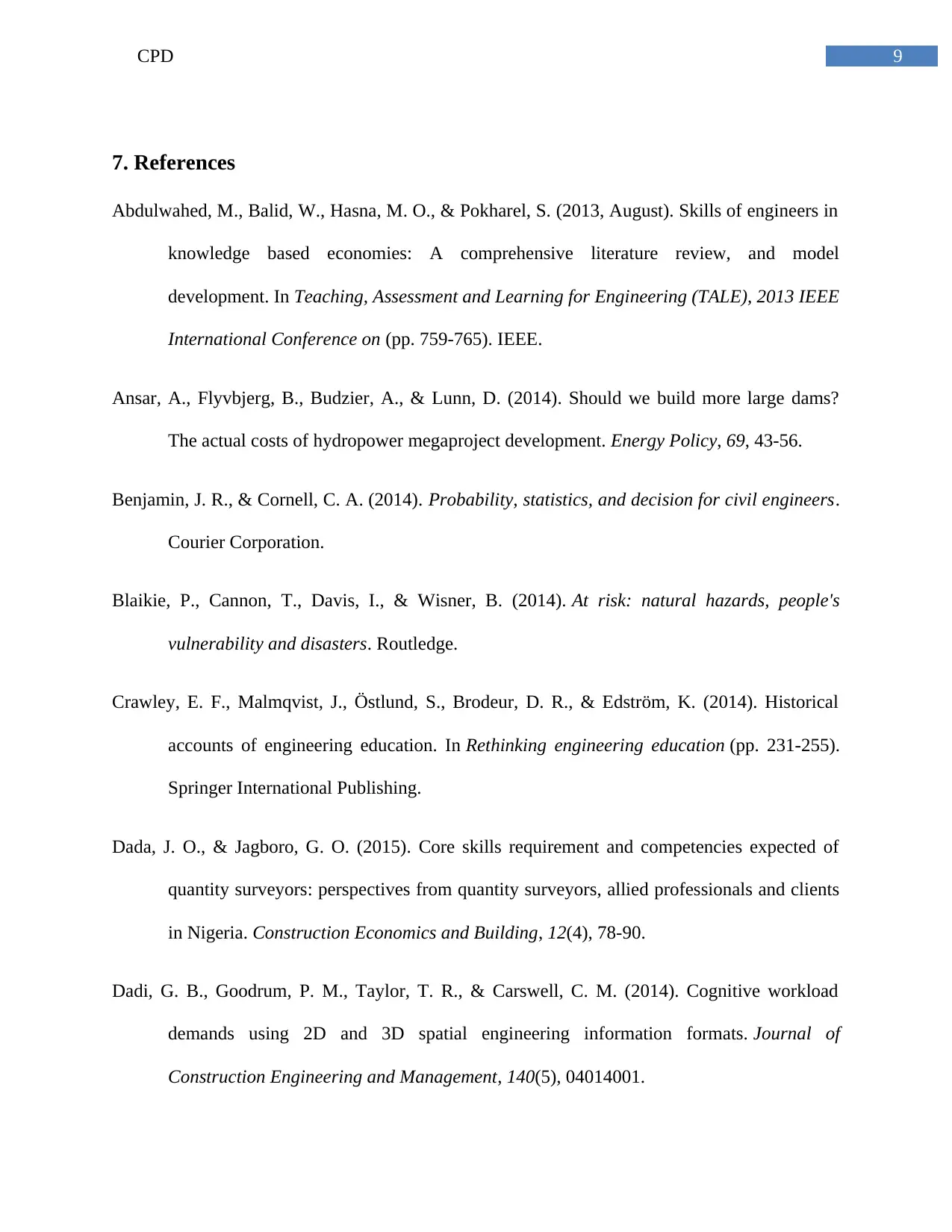
9CPD
7. References
Abdulwahed, M., Balid, W., Hasna, M. O., & Pokharel, S. (2013, August). Skills of engineers in
knowledge based economies: A comprehensive literature review, and model
development. In Teaching, Assessment and Learning for Engineering (TALE), 2013 IEEE
International Conference on (pp. 759-765). IEEE.
Ansar, A., Flyvbjerg, B., Budzier, A., & Lunn, D. (2014). Should we build more large dams?
The actual costs of hydropower megaproject development. Energy Policy, 69, 43-56.
Benjamin, J. R., & Cornell, C. A. (2014). Probability, statistics, and decision for civil engineers.
Courier Corporation.
Blaikie, P., Cannon, T., Davis, I., & Wisner, B. (2014). At risk: natural hazards, people's
vulnerability and disasters. Routledge.
Crawley, E. F., Malmqvist, J., Östlund, S., Brodeur, D. R., & Edström, K. (2014). Historical
accounts of engineering education. In Rethinking engineering education (pp. 231-255).
Springer International Publishing.
Dada, J. O., & Jagboro, G. O. (2015). Core skills requirement and competencies expected of
quantity surveyors: perspectives from quantity surveyors, allied professionals and clients
in Nigeria. Construction Economics and Building, 12(4), 78-90.
Dadi, G. B., Goodrum, P. M., Taylor, T. R., & Carswell, C. M. (2014). Cognitive workload
demands using 2D and 3D spatial engineering information formats. Journal of
Construction Engineering and Management, 140(5), 04014001.
7. References
Abdulwahed, M., Balid, W., Hasna, M. O., & Pokharel, S. (2013, August). Skills of engineers in
knowledge based economies: A comprehensive literature review, and model
development. In Teaching, Assessment and Learning for Engineering (TALE), 2013 IEEE
International Conference on (pp. 759-765). IEEE.
Ansar, A., Flyvbjerg, B., Budzier, A., & Lunn, D. (2014). Should we build more large dams?
The actual costs of hydropower megaproject development. Energy Policy, 69, 43-56.
Benjamin, J. R., & Cornell, C. A. (2014). Probability, statistics, and decision for civil engineers.
Courier Corporation.
Blaikie, P., Cannon, T., Davis, I., & Wisner, B. (2014). At risk: natural hazards, people's
vulnerability and disasters. Routledge.
Crawley, E. F., Malmqvist, J., Östlund, S., Brodeur, D. R., & Edström, K. (2014). Historical
accounts of engineering education. In Rethinking engineering education (pp. 231-255).
Springer International Publishing.
Dada, J. O., & Jagboro, G. O. (2015). Core skills requirement and competencies expected of
quantity surveyors: perspectives from quantity surveyors, allied professionals and clients
in Nigeria. Construction Economics and Building, 12(4), 78-90.
Dadi, G. B., Goodrum, P. M., Taylor, T. R., & Carswell, C. M. (2014). Cognitive workload
demands using 2D and 3D spatial engineering information formats. Journal of
Construction Engineering and Management, 140(5), 04014001.
Paraphrase This Document
Need a fresh take? Get an instant paraphrase of this document with our AI Paraphraser
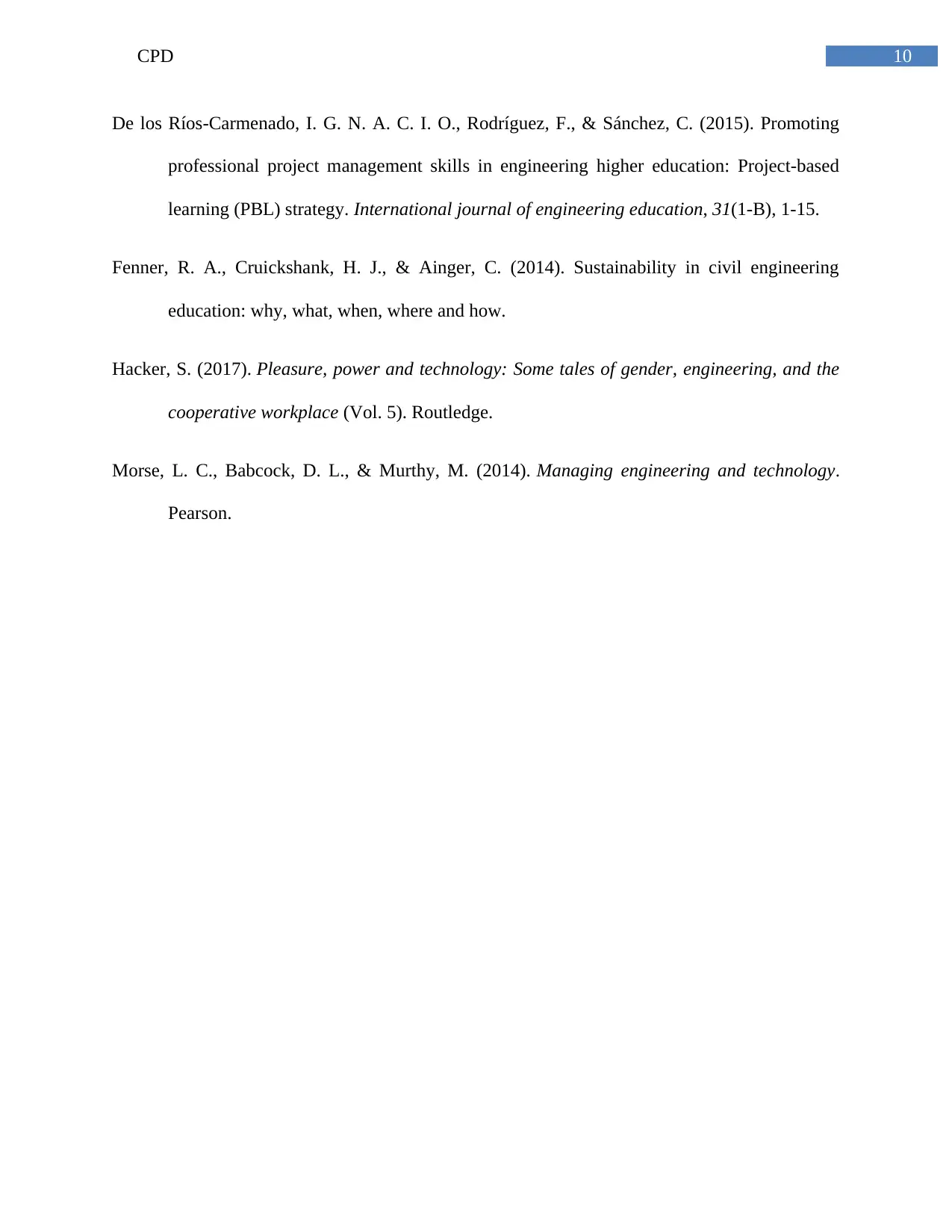
10CPD
De los Ríos-Carmenado, I. G. N. A. C. I. O., Rodríguez, F., & Sánchez, C. (2015). Promoting
professional project management skills in engineering higher education: Project-based
learning (PBL) strategy. International journal of engineering education, 31(1-B), 1-15.
Fenner, R. A., Cruickshank, H. J., & Ainger, C. (2014). Sustainability in civil engineering
education: why, what, when, where and how.
Hacker, S. (2017). Pleasure, power and technology: Some tales of gender, engineering, and the
cooperative workplace (Vol. 5). Routledge.
Morse, L. C., Babcock, D. L., & Murthy, M. (2014). Managing engineering and technology.
Pearson.
De los Ríos-Carmenado, I. G. N. A. C. I. O., Rodríguez, F., & Sánchez, C. (2015). Promoting
professional project management skills in engineering higher education: Project-based
learning (PBL) strategy. International journal of engineering education, 31(1-B), 1-15.
Fenner, R. A., Cruickshank, H. J., & Ainger, C. (2014). Sustainability in civil engineering
education: why, what, when, where and how.
Hacker, S. (2017). Pleasure, power and technology: Some tales of gender, engineering, and the
cooperative workplace (Vol. 5). Routledge.
Morse, L. C., Babcock, D. L., & Murthy, M. (2014). Managing engineering and technology.
Pearson.

11CPD
8. Appendices
Figure 1: Job Description 1
8. Appendices
Figure 1: Job Description 1
⊘ This is a preview!⊘
Do you want full access?
Subscribe today to unlock all pages.

Trusted by 1+ million students worldwide
1 out of 12
Related Documents
Your All-in-One AI-Powered Toolkit for Academic Success.
+13062052269
info@desklib.com
Available 24*7 on WhatsApp / Email
![[object Object]](/_next/static/media/star-bottom.7253800d.svg)
Unlock your academic potential
Copyright © 2020–2025 A2Z Services. All Rights Reserved. Developed and managed by ZUCOL.





